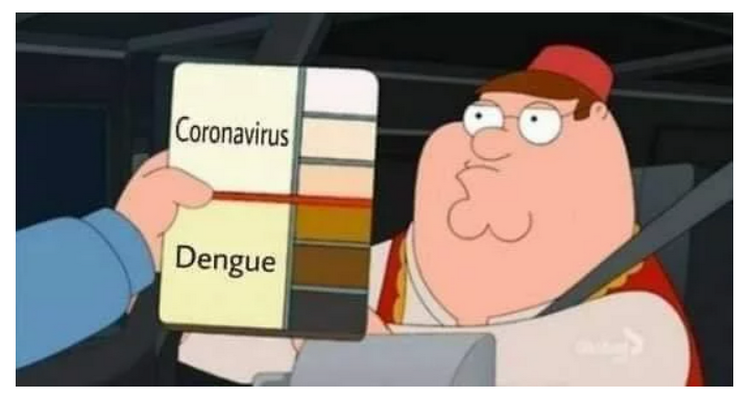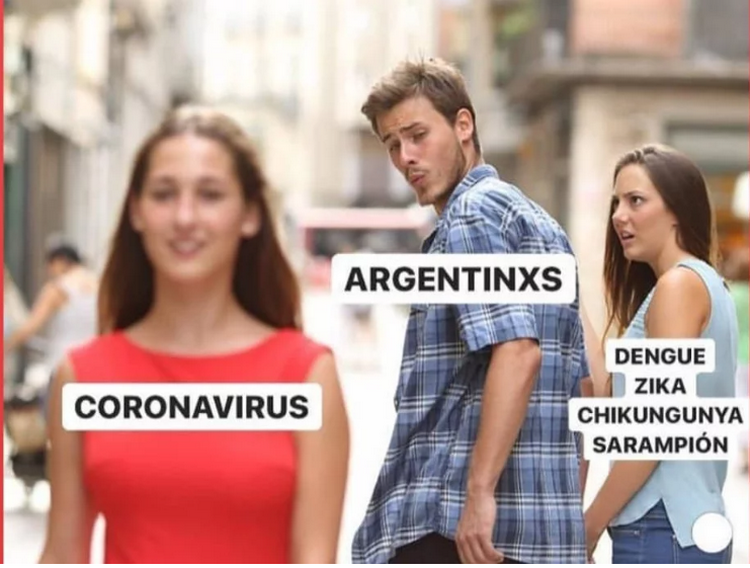
From the “disease of the rich” to the “disease of the poor”: Inequality, social perception and COVID-19 in Buenos Aires, Argentina
– Ana Villasenin, TU Berlin
During the COVID-19 pandemic social and economic inequalities have become both more visible and more polarized, which can be seen in the different reactions and strategies to confront the virus1. In this essay I intend to address how the social perception of COVID in the Argentinian context has shifted from a “disease of the rich” to a “disease of the poor”, and how this change had led to the development of differentiated policies to address the problem in marginalized urban contexts and informal settlements. I will be focusing on the actions taken in Buenos Aires metropolitan area2, the COVID-19 hotspot in Argentina.
In Argentina, an early lockdown prevented a health system collapse but also resulted in great social and economic problems. The “Stay at Home” recommendation is still in place at the time of writing; in the Argentinian winter of 2020 while the COVID cases are still multiplying, some further activities have been allowed to avoid an economic collapse and ease social tensions. The economic, political and social situation in Argentina before COVID was already fragile, with poverty growing dramatically, thousands of jobs lost and national debt re-negotiation in recent years. Just before the start of this pandemic a new president took office in December 2019, with the promise of changing the neo-liberal course of the past four years.
The first cases of COVID-19 registered in Buenos Aires City in March 2020 were people who came back from Europe. Meanwhile, there was a significant Dengue outbreak underway in the city, which was affecting the poorest neighborhoods in particular, where the preventive measures to avoid mosquitos were neglected. The massive media coverage of the few cases of COVID-19, as opposed to the much more widespread Dengue problem, was hailed by many via social media as a demonstration of a class bias: while hundreds of poor people were ill with Dengue, mass media was talking about a handful of upper- and middle-class individuals that came back from their European vacations with COVID (see Social Media Memes). As the number of cases grew, the mass media and even the government3 started blaming these “irresponsible” Argentinians that decided to travel abroad despite the warnings, and might be bringing back a dangerous disease as a souvenir. The idea of diseases as a foreign invasion4, was combined with class-based inequalities at a time of great political division in which the economic elite of the country were being blamed for prioritizing their interests over those of the less well-off classes. As a response the national government banned international flights, allowing only the repatriation of Argentinians who were abroad. The implementation was slow, and many citizens were stranded in various locations worldwide for months. Non-compliance with the mandatory quarantine of 15 days after arriving posed additional problems, and hotels were used for the quarantine of those arriving from the first COVID-19 ostensibly dangerous regions like Europe, the US or China.
By the end of March 2020, most of the population was under lockdown, with the exception of essential workers, and for all other citizens trips to the nearest grocery store. The community transmission rate of the virus rose significantly, and informal settlement dwellers voiced concerns as they lacked the basic infrastructure to comply with sanitary recommendations: Many of them did not have access to clean water, lived in overcrowded homes and did not have a formal job to guarantee their income while staying at home5. When the first COVID-19 cases appeared in informal settlements, there was great apprehension as no one knew whether the government would be able to control the situation6. Suddenly, the public perception shifted dramatically: While wealthy people could afford spending their lockdowns comfortably at home and therefore were complying with the recommendations, the poorest neighborhoods were the new hotspots for the spreading of the virus. Though at the beginning of the crisis the wealthy people were blamed for bringing the virus to the country, at this point housekeeping staff were being blamed for bringing the virus into the homes of the more affluent7.
In order to address the COVID-19 outbreak in informal settlements, local authorities combined two spatial strategies: On the one hand they unrolled an unprecedented strategy that entailed going door to door, block to block with security and health officers in order to inspect and partition the area and its population and create divisions between the infected residents, the residents at risk and the healthy residents. The implementation varied from neighborhood to neighborhood. In some extreme cases such as in “Villa Azul” people were prohibited from leaving the area for several weeks under any circumstance, which was enforced with military presence in the area. The second strategy was to install quarantine centers in order to guarantee that the people living in poor neighborhoods could comply with the sanitary requirements for quarantine8.
While the public attention shifted towards the outbreaks in these poor areas, the citizens arriving from abroad were allowed to quarantine at home, without any kind of effective state control. Middle class citizens with a confirmed COVID-19 infection but without severe symptoms were also allowed to stay at home, with minimal checks9.
The spatial strategies implemented by the state to deal with the infected population is one of many ways social inequalities are inscribed into the urban landscape. The restriction on mobility, where only essential workers can use public transport, or the fact that certain activities such as private construction or domestic work have been the ones that have taken the longest to re-establish, have a disproportionate impact on the lowest income groups: They are the ones that mostly depend on public transport and work in these fields. Additionally, the jobs that can be carried out at home are usually the ones of the educated middle class. But maybe the most telling example of the way the inequality gap is widening due to the pandemic concerns the access to primary education. After the suspension of classes in March some children were able to stay in touch with their teachers and classmates online. However, due to the huge gap in internet access10 many children are being deprived of their right to education. The Buenos Aires City Government has been urged to enforce this right in the city and responded by opening the schools and allowing underprivileged students to go there to access their online classes. While children of the middle and higher classes can continue studying without risking their and their family’s health, the poorest kids can only access the virtual classes by going to the school building. For them, and for their parents, immobility is not an option as they cannot afford it. For them immobility is equated with social immobility and the lack of access to basic rights.
As I have pointed out, during the different stages of the COVID-19 spread in Buenos Aires, both the social perception and the strategies towards the pandemic have changed. In the early stages, the virus was perceived as foreign and spread by rich people, and the government strategy included shutting down the borders and isolating the travelers, at home or in hotels. Strict surveillance was imposed on this group when they were forced to stay in hotels, and only lasted until community transmission became stronger and social perception changed. At this point, it became clear that the impact of the virus in areas with poor sanitation infrastructure could be devastating. The virus became a problem of the informal settlements and for the poor that could not comply with the public health authorities’ recommendations. The strategies taken by the government might be understood in two different ways. On the one hand, we witnessed an unprecedented intervention in which the presence of police and military forces, together with isolation centers for the infected, might be read as repressive strategies for controlling the population. This type of surveillance strategy was carried out mainly in poor neighborhoods. On the other hand, these neighborhoods effectively needed the presence of the state to avoid a health crisis. The door-to-door health campaign, and the availability of isolation centers for families living in overcrowded conditions, cannot be understood simply as a policy of state control, but also as a policy of access to rights.
The differentiated spatial strategies of the government are a consequence of the structural inequality that exists in the city. People living in informal settlements have a different experience with the state and the health system, then their wealthier counterparts, not only during the COVID-19 crisis, but throughout their entire lives. In any case, the COVID-19 crisis brings under the spotlight and into public debate the structural inequalities that this population faces: the lack of access to decent living conditions, and to basic rights such as health, formal jobs, education, and connectivity. In the face of this complex host of issues, the government took a crisis intervention approach, focusing on preventing the virus from spreading. It remains to be seen whether the government’s different departments will act on the structural problems that make this population more vulnerable to crises, and if the discussions about the differentiated access of this population to basic rights will remain in the public agenda.
At the time of writing, it is not possible to say whether or not the government has begun to close this gap; no significant infrastructure projects have been announced to guarantee safe drinking water and sewage in the informal settlements. School children have not been provided with computers or internet access. And, as social fatigue becomes more visible, the situation in informal settlements has largely ceased to be a subject of debate in the media and has been replaced by the demand for the opening of more and more activities and the forthcoming summer holidays.
Social Media Memes
This is a selection of Social Media Memes11 are from the early days of the Pandemic and address the issue of COVID as a foreign invader or as a class issue. At that moment in time (March 2020), COVID was a “disease of the rich”.

Image 1. Blaming the people who came back from Europe. Source: www.quepasaweb.com.ar 11

Image 2. Foreign disease vs local diseases. Source: www.quepasaweb.com.ar 11

Image 3. – Mr Dengue, What’s your opinion about the Coronavirus? – They come from outside and they steal our jobs! Source: www.quepasaweb.com.ar11

Image 4. COVID-19 as a racial issue. Source: www.quepasaweb.com.ar 11
Notes
1. See: UN – Conferencia Nelson Mandela (2020). Encarar la pandemia de la desigualdad: Un nuevo contrato social para una nueva era [online]. Available at https://www.un.org/es/coronavirus/articles/tackling-inequality-new-social-contract-new-era [Accessed 17 Dec 2020].
See also: Suaya, A. (2020). BID – IADB [online]. Available at: https://blogs.iadb.org/igualdad/es/la-ciudad-de-la-furia-desigualdad-en-la-pandemia/ [Accessed 17 Dec 2020].
2. Buenos Aires metropolitan area is the most populated region in Argentina. It is divided into two administrative and political districts: Buenos Aires City and Buenos Aires Province. While the first one is the richest district of the country and it is governed by an opposition party, Buenos Aires Province is the most populated district and the district with the greatest number of informal settlements nationwide.
For more data on informal settlements see the official report: Ministerio de salud y desarrollo social. Presidencia de la Nacion Argentina (2019). Integración Social Urbana de Barrios Populares [online]. Available at: https://www.argentina.gob.ar/sites/default/files/integracion_socio_urbana_de_barrios_populares.pdf [Accessed 17 Dec 2020].
3. See: Dinatale, M. (2020). El Gobierno dijo que 30.000 argentinos se fueron en medio de la pandemia y fijará prioridades para la repatriación. INFOBAE, 21 03 [online]. Available at: https://www.infobae.com/politica/2020/03/21/el-gobierno-dijo-que-30000-argentinos-se-fueron-en-medio-de-la-pandemia-y-fijara-prioridades-para-la-repatriacion/ [Accessed 17 Dec 2020].
Or: TELAM (2020). A pesar de la pandemia, más de 30 mil argentinos dejaron el país entre el 13 y el 19 de marzo. TELAM, 21 03 [online]. Available at: https://www.telam.com.ar/notas/202003/443388-argentina-coronavirus-migraciones-argentinos-viaje.html [Accessed 17 Dec 2020].
4. Sontag, S. (1989). AIDS and Its Metaphors. New York: Farrar, Straus and Giroux.
5. The problem of the lack of income of most of informal workers was partly solved by the National Government as they unroll a program called “Ingreso Familiar de Emergencia” (Family Emergency Income) where families with no income can apply for a monthly income fund by the government for the duration of the pandemic.
For more info about this program consult the official website: ANSES (2020). ANSES.GOB [online]. Available at: https://www.anses.gob.ar/ingreso-familiar-de-emergencia [Accessed 21 Sept 2020].
6. See: Hojman, I. F. (2020). Preocupación en los vecinos de los barrios populares por el aumento de casos de coronavirus. TELAM, 14 05 [online]. Available at: https://www.telam.com.ar/notas/202005/463971-vecinos-barrios-populares-ciudad-buenos-aires-coronavirus.html [Accessed 17 Dec 2020].
Or: INFOBAE (2020). Preocupación por el avance del coronavirus en las villas porteñas: ya se confirmaron 124 casos. INFOBAE, 30 04 [online]. Available at: https://www.infobae.com/sociedad/2020/04/30/coronavirus-en-argentina-los-contagios-en-los-barrios-populares-portenos-ya-son-el-10-del-total-de-casos-registrados-en-capital-federal/ [Accessed 17 Dec 2020].
7. Although activities linked to domestic services were not among the authorized activities, due to the large percentage of informal employment in the sector and the fear of workers losing their jobs, many continued to go to work. A paradigmatic case was that of model and actress Nicole Neumann, who, when she got COVID, blamed the housemaid. She also stated that during the quarantine, the housemaid was only allowed to visit her family every 15 days, meanwhile, the model continued to go to work, exposing herself to the COVID.
For more info on the housemaid’s situation and Nicole Neumann accusations see: Rusa, M. & Lagomarsino, P. (2020). Famosos y funcionarios culpan de contagios a empleadas domésticas. Prensa Obrera, 09 08 [online]. Available at: https://prensaobrera.com/sindicales/famosos-y-funcionarios-culpan-de-contagios-a-empleadas-domesticas/ [Accessed 17 Dec 2020].
8. For more data about quarantine measures see:
– Gobierno de la Ciudad de Buenos Aires, (2020). Cómo es el centro de aislamiento de Costa Salguero [online]. Available at: https://www.buenosaires.gob.ar/atencionygestionciudadana/gestion-comunal/noticias/como-son-las-instalaciones-del-nuevo-centro-de [Accessed 17 Dec 2020].
– Gobierno de la Ciudad de Buenos Aires (2020). Protocolo de manejo de casos sospechosos y confirmados COVID-19 en aislamiento en intituciones extrahospitalarias [online]. Available at: https://www.buenosaires.gob.ar/sites/gcaba/files/p.extrahospitalarios_1_1.pdf [Accessed 17 Dec 2020].
– Gobierno de la Ciudad de Buenos Aires (2020). Protocolo de actuación frente a la propagación del COVID-19 en barrios populares [online]. Available at: https://www.buenosaires.gob.ar/sites/gcaba/files/if-2020-19895887-gcaba-mdhyhgc_-_protocolo_1.pdf [Accessed 17 Dec 2020].
– TELAM (2020). Coronavirus: construyen dos centros de aislamiento para el Barrio 31 con 1.400 camas. TELAM, 21 05 [online]. Available at: https://www.telam.com.ar/notas/202005/466497-coronavirus-construccion-centros-aislamiento-barrio-31.html [Accessed 17 Dec 2020].
– TELAM (2020). Villa Azul: empezó hoy la etapa de aislamiento focalizado. TELAM, 08 06 [online]. Available at: https://www.telam.com.ar/notas/202006/473595-comenzo-hoy-la-etapa-de-aislamiento-focalizado-en-villa-azul.html [Accessed 17 Dec 2020].
– Vera, F. (2020). ¿Cómo responder efectivamente a la pandemia de la COVID-19 en asentamientos informales de alta densidad? El caso del Barrio 31, Buenos Aires. BID, 08 07 [online]. Available at: https://blogs.iadb.org/ciudades-sostenibles/es/asentamientos-barrios-informales-coronavirus-covid19-pandemia-barrio-31-ciudad-buenos-aires-densidad-poblacional-poblacion-vulnerable-medidas-prevencion-contencion/ [Accessed 17 Dec 2020].
9. See: Ministerio de Salud de la Nación Argentina (2020). COVID-19 Recomendaciones para la atención domiciliaria de casos sospechosos y confirmados [online]. Available at: http://www.msal.gob.ar/images/stories/bes/graficos/0000001942cnt-covid-19-recomendaciones-para-atencion-domiciliaria-de-casos-sospechosos-y-confirmados.pdf [Accessed 17 Dec 2020].
10. According to the report from the Observatorio de la Deuda Social Argentina – UCA, 47% of Children From 5 to 17 years old don´t have access to an Internet connection in their Home. This lack of connection it is not equally distributed: While only 0.3% of children living in Houses from the “Professional Middle Class” do not have access, 19,1% of the children living in Houses from the “Non-Professional Middle Class” lacked internet access. 49.8% of the children from Houses of “Formal Workers” don´t have access to internet at home and the percentage rise to 67,3% when talking about the children of houses of “Informal Workers”.
To see more data on this topic consult: Observatorio de la Deuda Social Argentina – UCA (2020). Desigualdades Sociales en Tiempos de Pandemia, Buenos Aires: Universidad Católica Argentina [online]. Retrieved from http://wadmin.uca.edu.ar/public/ckeditor/Observatorio%20Deuda%20Social/Documentos/2020/OBSERVATORIO-COMUNICADO-ODSA%20INFORMA-%202-31_03_VF.pdf [Accessed 17 Dec 2020].
11. All these memes have been retrieved from: Que Pasa Web (2020). Pandemia de memes por el coronavirus: Más chistes que infectados. Que Pasa Web, 13 03 [online]. Available at: https://www.quepasaweb.com.ar/pandemia-de-memes-por-el-coronavirus-mas-chistes-que-infectados/ [Accessed 17 Dec 2020].
Special Issue, COVID-19 one year in
